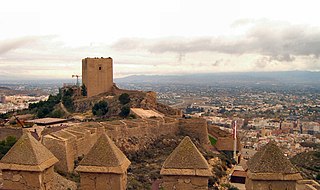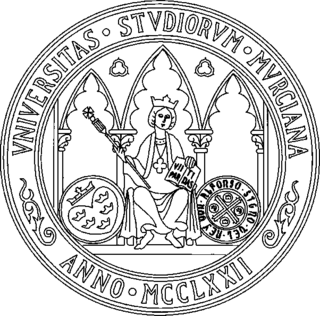
Lorca is a municipality and city in the autonomous community of the Region of Murcia in south-eastern Spain, 58 kilometres (36 mi) southwest of the city of Murcia. The municipality had a population of 95,515 in 2020, up from the 2001 census total of 77,477. Lorca is the municipality with the second largest surface area in Spain, 1,675.21 km2 (646.80 sq mi), after Cáceres. The city is home to Lorca Castle and the Collegiate church dedicated to St. Patrick.

Totana is a municipality in the Region of Murcia in Spain. It has a population of 32008. The local economy is largely dependent on agriculture and related industries. It has a railway station providing a service on the Cercanías Murcia/Alicante commuter line, providing connections to Alicante and Murcia.

The University of Murcia is the main university in Murcia, Spain. With 38,000 students, it is the largest university in the Región de Murcia. The University of Murcia is the third oldest university in Spain, after the University of Salamanca and the University of Valladolid, and the thirteenth in the world. The University of Murcia was established in 1272 by the King Alfonso X of Castile under the Crown of Castile.
Coy is a town within the municipality of Lorca, in the Spanish province of Murcia. It has a population of 511 and is located 22 miles north of Lorca. Previously known for their supply of metals, they are now known for their wine and traditional crafts.
David Vidal Tomé is a Spanish football manager and former player who played as a centre back.

The Region of Murcia, is an autonomous community of Spain located in the southeastern part of the Iberian Peninsula, on the Mediterranean coast. The region is 11,313 km2 (4,368 sq mi) in area and had a population of 1,511,251 as at the start of 2020. About one-third of its population lives in the capital, Murcia. At 2,014 m (6,608 ft), the region's highest point is Los Obispos Peak in the Massif of Revolcadores.

Cercanías Murcia/Alicante is a commuter rail service (cercanías) in the provinces of Alicante and Murcia. The line connects Alicante and Murcia with San Vicente del Raspeig, Elche, Orihuela, Totana, Lorca, and Águilas. It runs through 200 km of railways with a total of 26 stations.

The 2011 Lorca earthquake was a moderate 5.1 earthquake that occurred 6:47 p.m. CEST on 11 May 2011, near the town of Lorca, causing significant localized damage in the Region of Murcia, Spain, and panic among locals, and displacing many from their homes. The quake was preceded by a magnitude 4.4 foreshock at 17:05, that inflicted substantial damage to many older structures in the area, including the historical Espolón Tower of Lorca Castle, the Hermitage of San Clemente and the Convent of Virgen de Las Huertas. Three people were killed by a falling cornice. A total of nine deaths have been confirmed, while dozens are reported injured. The earthquake was the worst to hit the region since a 5.0 Mw tremor struck west of Albolote, Granada in 1956.

Castle of Lorca in Lorca, Murcia, Spain, is a fortress of medieval origin constructed between the 9th and 15th centuries. It consists of a series of defensive structures that, during the Middle Ages, made the town and the fortress an impregnable point in the southeast part of the Iberian Peninsula. Lorca Castle was a key strategic point of contention between Christians and Muslims during the Reconquista. It is listed as a Site of Cultural Interest.

Aledo is a municipality in the Region of Murcia, southern Spain.

Lorca Fútbol Club was a Spanish football team based in Lorca, in the autonomous community of the Region of Murcia. Founded in 2003, it last played in Preferente Autonómica de Murcia – Group 1, holding home games at Estadio Francisco Artés Carrasco, which has a capacity of 8,120.

Club de Fútbol Lorca Deportiva is a Spanish football club based in Lorca, in the autonomous community of the Region of Murcia. Founded in 2012, it plays in Tercera División RFEF – Group 13, holding home games at Estadio Francisco Artés Carrasco, with an 8,100-seat capacity.

Fútbol Club Jumilla was a Spanish football team based in Jumilla, in the autonomous community of Murcia. Founded in 2011, it played in Segunda División B – Group 4, holding home matches at Estadio Municipal de La Hoya. Between 2016 and 2019, its reserve team was Estudiantes de Murcia CF. In August 2019, unable to pay its debts, the club was dissolved.

Almendricos is a village in Murcia, Spain. It is part of the municipality of Lorca.
Zarcilla de Ramos is a village in Murcia, Spain. It is part of the municipality of Lorca.
Zarzadilla de Totana is a village in Murcia, Spain. It is part of the municipality of Lorca.
Doña Inés is a village in Murcia, Spain. It is part of the municipality of Lorca.
La Paca is a village in Murcia, Spain. It is part of the municipality of Lorca.
Sutullena is a village in Murcia, Spain. It is part of the municipality of Lorca.
The Murcia–Almería high-speed rail line is an under-construction railway in the Region of Murcia and Andalusia in Spain.












